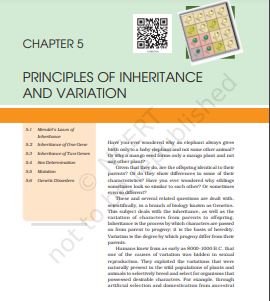Principles of Inheritance And Variation PDF Free Download

Chapter 5: Principles of Inheritance and Variation
Have you ever wondered why an elephant always gives birth only to a baby elephant and not some other animal?
Or why a mango seed forms only a mango plant and not any other plant? Given that they do, are the offspring identical to their parents? Or do they show differences in some of their characteristics?
Have you ever wondered why siblings sometimes look so similar to each other? Or sometimes even so different?
These and several related questions are dealt with, scientifically, in a branch of biology known as Genetics.
This subject deals with the inheritance, as well as the variation of characters from parents to offspring. Inheritance is the process by which characters are passed on from parent to progeny; it is the basis of heredity.
Variation is the degree to which progeny differ from their parents. Humans knew from as early as 8000-1000 B.C. that one of the causes of variation was hidden in sexual reproduction.
They exploited the variations that were naturally present in the wild populations of plants and animals to selectively breed and select for organisms that possessed desirable characteristics. For example, through artificial selection and domestication from ancestral
wild cows, we have well-known Indian breeds, e.g., Sahiwal cows in Punjab. We must, however, recognize that though our ancestors knew about the inheritance of characters and variation, they had very little idea about the scientific basis of these phenomena.
5.1 MENDEL’S LAWS OF INHERITANCE
It was during the mid-nineteenth century that headway was made in the understanding of
inheritance.
Gregor Mendel conducted hybridization experiments on garden peas for seven years (1856-1863) and proposed the laws of inheritance in living organisms.
During Mendel’s investigations into inheritance patterns, it was for the first time that statistical
analysis and mathematical logic were applied to problems in biology. His experiments had a large sampling size, which gave greater credibility to the data that he collected.
Also, the confirmation of his inferences from experiments on successive generations of his test plants proved that his results pointed to general rules of inheritance rather than being unsubstantiated ideas.
Mendel investigated characteristics in the garden pea plant that was manifested as two opposing traits, e.g., tall or dwarf plants, yellow or green seeds.
This allowed him to set up a basic framework of rules governing inheritance, which was expanded on by later scientists to account for all the diverse natural observations and the complexity inherent in them.
| Author | – |
| Language | English |
| No. of Pages | 28 |
| PDF Size | 18.4 MB |
| Category | Biology |
| Source/Credits | – |
Principles of Inheritance And Variation PDF Free Download
